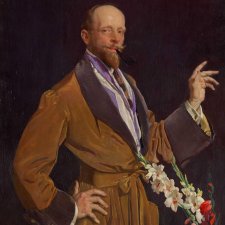George Lambert (1873–1930), artist, was born in St Petersburg and lived in Germany and England before coming to Australia with his family at the age of fourteen. He lived on his uncle's north-west NSW farm, working as a jackeroo and becoming friendly with Breaker Morant and Banjo Paterson before coming to Sydney to work as an illustrator for the Bulletin. He studied at the Julian Ashton Art School in Sydney from 1896 to 1900, when winning the first NSW Travelling scholarship enabled him to spend a year in Paris. He was successful both there and in London, where he exhibited at the Royal Academy and the New Salon and gained a reputation as a raconteur and man about town. During the First World War, as the only official war artist to be appointed to the rank of Honorary Captain, he produced immense, violent paintings of the landing at Gallipoli and the charge of the Light Horse at Beersheba. When he returned to Sydney in 1921 he was the most glittering figure of the art world, and between 1920 and 1930 his paintings dominated the Australian art scene. At the same time, he encouraged a new generation of modernist artists such as Thea Proctor, Roy de Maistre, Roland Wakelin and Grace Cossington Smith. Toward the end of his life, with his pupil Arthur Murch, he created the figure of the unknown soldier in St Mary's Basilica, Sydney. For Sydney's Domain he also made the statue of another old acquaintance, Henry Lawson, a work, like his war paintings, that has significantly influenced notions of Australian identity. He won the Wynne Prize in 1899, the Archibald Prize in 1927, and was an Associate of the Royal Academy.
- About us
- Support the Gallery
- Venue hire
- Publications
- Research library
- Organisation chart
- Employment
- Contact us
- Make a booking
- Onsite programs
- Online programs
- School visit information
- Learning resources
- Little Darlings
- Professional learning







